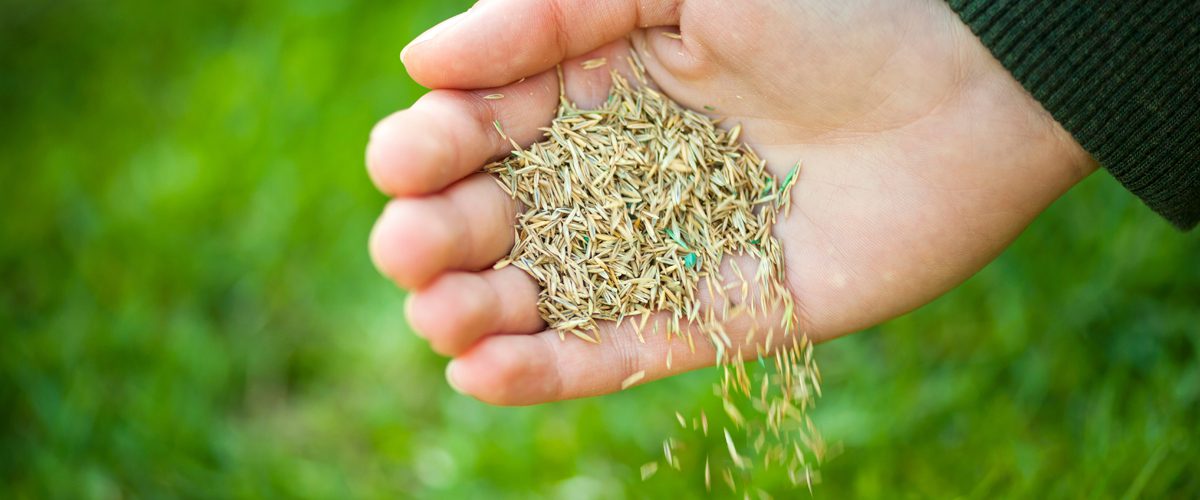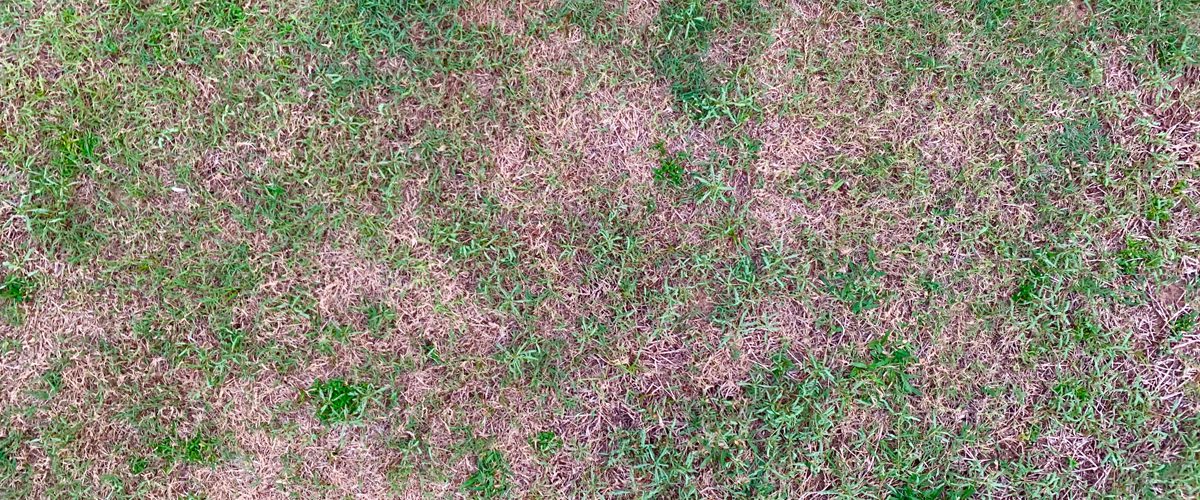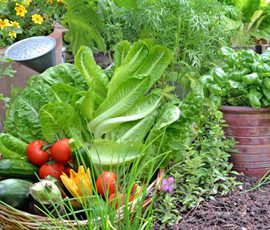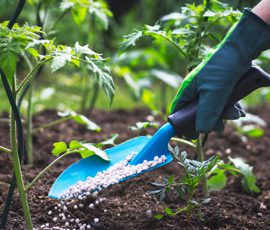
If you have ever thought about overseeding your lawn or wondered what the benefits are, you’re in the right place. Overseeding is one of the best ways to ensure your lawn stays healthy and luscious through all kinds of weather. Keep reading to see the top 5 tips and tricks for overseeding your lawn in the fall.
What is “overseeding”?
Overseeding might seem self-explanatory, but it might also be a different idea than you think. Reseeding is the act of starting a lawn with fresh soil and seeds but overseeding is when you seed over the existing grass to ensure it stays healthy and fresh. There are a few ways you can overseed, depending on what your lawn needs in the first place.
Why would I need to overseed?
If you have noticed that your lawn has started to become patchy, overall sparse, or there is damage from kids and pets, then it’s a good idea to overseed so that the lawn doesn’t become worse.
Tip #1) Catch the damage: Long-term damage to your yard can be challenging to come back from, so it’s best to catch it and fix it as soon as you notice a significant issue. You can even rope off the area if you need to before the damage gets worse.

How can I overseed my lawn in the fall?
If you have overseeded in the spring to bring your lawn back to life and you’ve been wondering how to overseed in the fall, there’s not much of a difference. You will be treating the areas that need it most with a bit of extra product while distributing the rest throughout the yard evenly. If you have an early fall leave shed, then you should make sure to rake it up before you seed.
The first step you should do if you decide to add some extra seeds to your lawn is to mow it slightly lower than you usually would. This way, the seeds you plant won’t end up floating on the grass, and they can have an easier time finding fresh soil.
Another step you can take if your lawn is in need of quite a bit of help is to consider aerating it. Aerating will create small holes, slashes, or divots in the ground to allow water, fertilizer, and lawn seeds to get deep into the roots. This is an excellent option for yards with thicker soil issues, and we’ll talk more about aerating and dethatching your lawn later on.
Tip #2) Gather up your grass: You should also make sure that you are raking up the mowed grass after removing the layer while churning up the dirt a bit. Another option you have is to mulch the grass right afterward so the smaller pieces can break down instead of building up.
You should also make sure you are choosing the correct seeds for your climate and lifestyle. Some grasses need a different watering schedule or are more suited to different environments, so it’s good to do some research beforehand. There are also grass seeds that are meant for overseeding, and these ones usually contain quick-grow seeds along with fertilizer and nutrients to help your lawn go from sparse to luscious.
What should I consider before overseeding?
You need to identify what your problems are before you start looking at how to fix the problems that you have. Find the parts of your yard that look the worst and try to figure out if there is a specific reason they aren’t looking the best. You might not need to overseed the entire lawn if there are just a few issues around the yard that need to be taken care of.
If your entire lawn is looking rough, you might want to consider renting or buying a seed spreader. These are often used for larger yards, but you can also use them for medium-sized areas to ensure that the seeds are spread in an even layer and distributed thoroughly. Hand sprinkling should be saved for smaller yards as it can be time-consuming and sometimes result in patchy grass.
Tip #3) Keep rolling, rolling, rolling: Rolling seed spreaders are about $50 to purchase, but you can also look at a smaller hand crank seed spreader if you want a less expensive option. These are widely available at most hardware stores and garden centers, but you can purchase them online if you can’t find one in your area.
We already mentioned that different grass seeds could help different areas. Some are designed to grow quickly (which is perfect if you want to sell your home and need your lawn in good shape fast), while others are designed to provide you with a stronger lawn (which is ideal for those with kids, pets, or lots of traffic on their grass). Some seeds have specific purposes, such as those meant to help the lawn recover from pet waste or seeds designed to grow well in the shade. Make sure you choose the right type of seed for your lawn, or you might waste your time and money.
Finally, make sure that your soil is in good condition to grow some fresh grass by checking the ph level. An ideal ph level for a lawn will sit in between 6.0 and 6.8, but if yours is out of range, you can alter it by treating the yard by adding lime (for a ph that is too low) or sulfur (for a ph that is too high). You can also consider adding a very thin layer of compost or additional soil that can help give the seeds a good place to make their home.
Another common problem you might have with your soil is soil that is too compact to accept new seeds. Thatch (extra grass clipping and debris that form a barrier against the soil) and pressed down soil can be hard to deal with, and you might need to look into “dethatching” the lawn using a specific tool like a rototiller, a dethatcher, or an aerator to break up the layer of gunk. Make sure you are only focusing on areas that need to be fixed, and make sure that you aren’t breaking up the ground too much with the equipment.
When should I consider overseeding my lawn?
This is another thing that depends on your lawn type, your lifestyle, and the climate you live in. If you are wondering when to overseed your lawn in Ontario, then you want to look for the cooler summer months. The end of summer/beginning of fall is one of the best times to add some extra growth to your yard to ensure it stays nice and healthy over the winter months.
When winter comes in, your lawn will stop growing and go into sort of a “hibernation” mode until the temperatures go back up. In order to make sure it stays the same, you should do a bit of extra maintenance to help give it a bit of a boost. We mentioned aerating earlier, which is one of the best ways to ensure that your overseed will be beneficial.
Tip #4) Find the magic formula: The best system to keep your yard healthy is a combination of aeration, overseeding, and using the correct fertilizer. An overseeding product is the best choice for this job, and there are plenty of different ones on the market that have the perfect combination of fertilizer, seeds, and nutrients to keep your lawn safe.
You should also make sure to water your lawn daily after you have overseeded to allow for the soil to absorb the seeds better. If you have an irrigation system that you usually use for watering, make sure you don’t “winterize it” until you get your seeds appropriately watered for a few weeks.
Tip #5) Use what you’ve got: If you have an irrigation system, you can also use this to fertilize your lawn by applying liquid fertilizer to the watering system. Only do this if your seeds do not have added fertilizer; otherwise, you could risk damaging your lawn by throwing off the natural ph balance too much.
You also need to consider the sunlight your lawn will receive. If you don’t get much sun in the first place, then consider getting a grass seed that is made to grow in the shade. In the fall, many trees have started to become sparse, which allows for more light to shine on your lawn, so you might need to water your seed more often.
If you have any questions about repairing your yard, contact a local lawn expert or landscaping company in your area. They are well trained at figuring out the type of grass seed you will need, and they can apply it professionally so you can make sure it is done the first time correctly. They can also give you some great tips and tricks related to your lawn specifically, as well as a guide to help you keep it maintained all year round.


